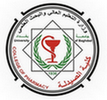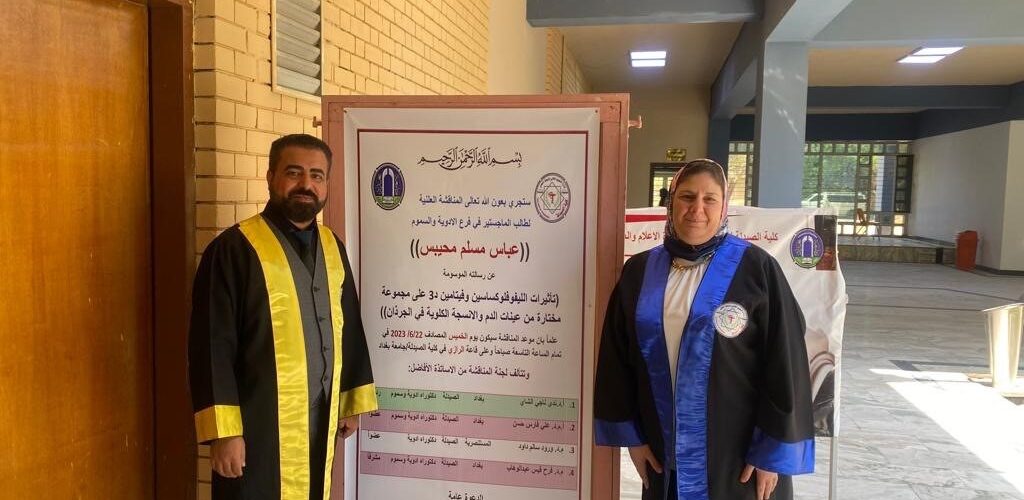The faculty of pharmacy discussed the M.Sc. Degree thesis, taged Ameliorative Effects of Vitamin D3 against Some Hematological and Renal Toxic Effects of Levofloxacin in Rats, by Abbas Muslim Mhaibes and the supervisor, lecturer Dr. Farah Kais Abdulwahab, in the Department of Pharmacology and Toxicology. The thesis aimed to evaluate the effect of vitamin D3 and levofloxacin on hematological parameters and renal tissue by measuring oxidative stress, biochemical parameters, and histopathological studies in rats by: Evaluating the effect of vitamin D3 and levofloxacin on renal function tests by measuring serum urea and serum creatinine levels and evaluating the possible protective effect of vitamin D3 on levofloxacin-induced hematological changes by measuring the complete blood picture (red blood cells, hemoglobin, mean corpuscular volume, mean corpuscular hemoglobin, mean corpuscular hemoglobin concentration, platelets, white blood cells, and differential white blood cells) Evaluating the possible anti-oxidant effect of vitamin D3 on levofloxacin-induced nephrotoxicity by measuring renal malondialdehyde, reduced glutathione, and superoxide dismutase tissue levels and evaluating the effects of vitamin D3 and levofloxacin on renal histological sections. The thesis included Forty-two (42) white Albino rats weighing 150–250 grams were divided into six groups (7 rats in each group). Group I (control): 7 rats received intraperitonial (0.5 ml/day) of normal saline for 21 days; Group II (dose levofloxacin 50mg/kg/day intraperitonial for fourteen days); Group III (levofloxacin 100 100mg/kg/day intraperitonial for fourteen days); Group IV (vitamin D3 500 IU/rat/day orally by oral gavage for twenty-one days). GroupV (vitamin D3 500 IU/rat/day orally for twenty-one days and levofloxacin 50 mg/kg/day intraperitoneally administered at day 8 for fourteen days) Group VI (vitamin D3 500 IU/rat/day for twenty one days orally and levofloxacin 100 mg/kg/day intraperitonial administered at day 8 for fourteen days) on day 15(Groups II and III) and day22(Groups I, IV, V and VI) all animals were euthanized and then serum samples were utilized for assessment of biochemical test (serum urea , serum creatinine and for hematology parameters (red blood cells , hemoglobin, mean corpuscular volume, mean corpuscular hemoglobin, mean corpuscular hemoglobin concentration, platelets ,white blood cells , differential WBCs (neutrophils , lymphocytes ,monocytes ,eosinophils ) while renal tissue homogenates were used for the estimation of malondaildehyde, reduced glutathione, superoxide dismutase enzyme levels using sandwich enzyme-linked immunosorbent assay method, In addition, a histological examination of rat kidney sections was made. The results concluded that The different doses of levofloxacin IP injected (for 14 days) into rats caused renal impairment as indicated by increased serum urea and creatinine levels, oxidant content (malondaildehyde), and apoptotic cells in renal tissue. Levofloxacin administration significantly reduced the number of red blood cells and non-significantly reduced hemoglobin concentration, packed cell volume, mean corpuscular hemoglobin concentration, and platelets when compared to the control group, according to the current study. When compared to the levofloxacin group, these indices (red blood cells, mean corpuscular volume, and mean corpuscular hemoglobin) significantly increased after oral vitamin D3 delivery seven days earlier. Vitamin D3 (cholecalciferol) duo has anti-oxidative properties that reduce the oxidant content of malondaildehyde and increase the anti-oxidant levels (reduced glutathione and superoxide dismutase) in rats’ kidney tissue homogenate, which are enhanced by an indirect pathway in some hematology parameters. A single dose of vitamin D3 combined with levofloxacin elicits a protective impact on renal tissues via antioxidant effects (reduction of malondaildehyde and rise in reduced glutathione and superoxide dismutase) levels, and some hematology parameters may be due to effects on erythropoietin and erythropoiesis.




